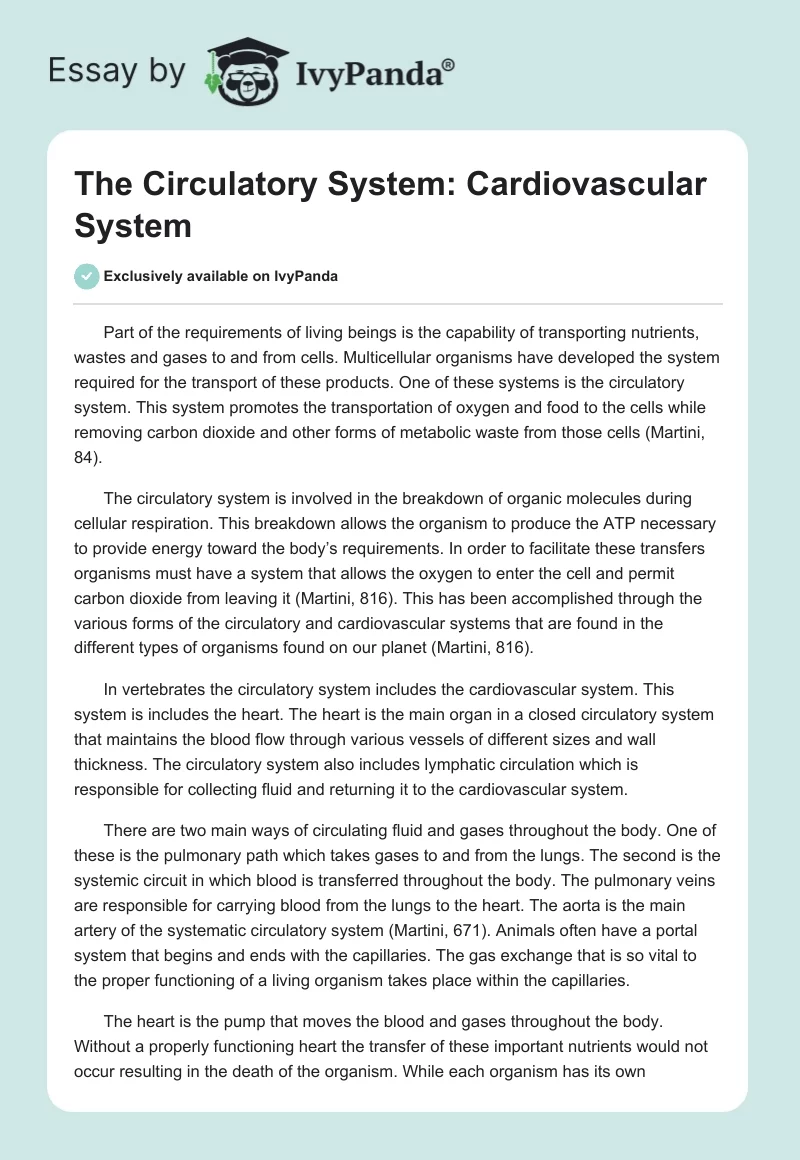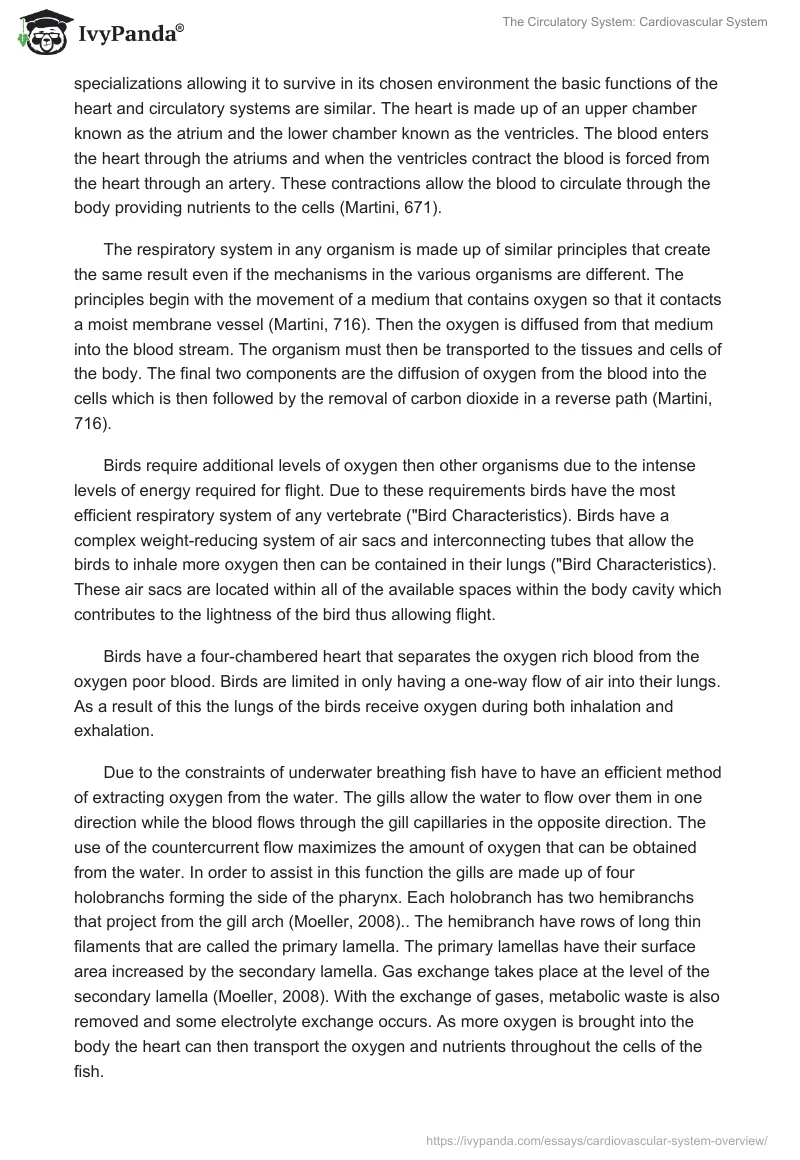Part of the requirements of living beings is the capability of transporting nutrients, wastes and gases to and from cells. Multicellular organisms have developed the system required for the transport of these products. One of these systems is the circulatory system. This system promotes the transportation of oxygen and food to the cells while removing carbon dioxide and other forms of metabolic waste from those cells (Martini, 84).
The circulatory system is involved in the breakdown of organic molecules during cellular respiration. This breakdown allows the organism to produce the ATP necessary to provide energy toward the body’s requirements. In order to facilitate these transfers organisms must have a system that allows the oxygen to enter the cell and permit carbon dioxide from leaving it (Martini, 816). This has been accomplished through the various forms of the circulatory and cardiovascular systems that are found in the different types of organisms found on our planet (Martini, 816).
In vertebrates the circulatory system includes the cardiovascular system. This system is includes the heart. The heart is the main organ in a closed circulatory system that maintains the blood flow through various vessels of different sizes and wall thickness. The circulatory system also includes lymphatic circulation which is responsible for collecting fluid and returning it to the cardiovascular system.
There are two main ways of circulating fluid and gases throughout the body. One of these is the pulmonary path which takes gases to and from the lungs. The second is the systemic circuit in which blood is transferred throughout the body. The pulmonary veins are responsible for carrying blood from the lungs to the heart. The aorta is the main artery of the systematic circulatory system (Martini, 671). Animals often have a portal system that begins and ends with the capillaries. The gas exchange that is so vital to the proper functioning of a living organism takes place within the capillaries.
The heart is the pump that moves the blood and gases throughout the body. Without a properly functioning heart the transfer of these important nutrients would not occur resulting in the death of the organism. While each organism has its own specializations allowing it to survive in its chosen environment the basic functions of the heart and circulatory systems are similar. The heart is made up of an upper chamber known as the atrium and the lower chamber known as the ventricles. The blood enters the heart through the atriums and when the ventricles contract the blood is forced from the heart through an artery. These contractions allow the blood to circulate through the body providing nutrients to the cells (Martini, 671).
The respiratory system in any organism is made up of similar principles that create the same result even if the mechanisms in the various organisms are different. The principles begin with the movement of a medium that contains oxygen so that it contacts a moist membrane vessel (Martini, 716). Then the oxygen is diffused from that medium into the blood stream. The organism must then be transported to the tissues and cells of the body. The final two components are the diffusion of oxygen from the blood into the cells which is then followed by the removal of carbon dioxide in a reverse path (Martini, 716).
Birds require additional levels of oxygen then other organisms due to the intense levels of energy required for flight. Due to these requirements birds have the most efficient respiratory system of any vertebrate (“Bird Characteristics). Birds have a complex weight-reducing system of air sacs and interconnecting tubes that allow the birds to inhale more oxygen then can be contained in their lungs (“Bird Characteristics). These air sacs are located within all of the available spaces within the body cavity which contributes to the lightness of the bird thus allowing flight.
Birds have a four-chambered heart that separates the oxygen rich blood from the oxygen poor blood. Birds are limited in only having a one-way flow of air into their lungs. As a result of this the lungs of the birds receive oxygen during both inhalation and exhalation.
Due to the constraints of underwater breathing fish have to have an efficient method of extracting oxygen from the water. The gills allow the water to flow over them in one direction while the blood flows through the gill capillaries in the opposite direction. The use of the countercurrent flow maximizes the amount of oxygen that can be obtained from the water. In order to assist in this function the gills are made up of four holobranchs forming the side of the pharynx. Each holobranch has two hemibranchs that project from the gill arch (Moeller, 2008).. The hemibranch have rows of long thin filaments that are called the primary lamella. The primary lamellas have their surface area increased by the secondary lamella. Gas exchange takes place at the level of the secondary lamella (Moeller, 2008). With the exchange of gases, metabolic waste is also removed and some electrolyte exchange occurs. As more oxygen is brought into the body the heart can then transport the oxygen and nutrients throughout the cells of the fish.
In fish the heart only has two chambers in which the single-loop circulatory pattern takes the blood from the heart passing through the ventral aorta and then the afferent branchial arteries to the gills to receive oxygen (Moeller, 2008). Once the blood gains the oxygen it returns through the efferent arteries to the dorsal aorta which then transports the blood throughout the rest of the body. Since the retina has a high demand for oxygen some blood is removed from the dorsal aorta and sent to the pseudobranch increasing the oxygen level before it is sent to the retina (Moeller, 2008).
Most reptiles breathe with their lungs and therefore must be able to move their ribs to breath. They do not have diaphragms like mammals do which increases their chances for a respiratory illness. Their hearts have four chambers that are divided by internal walls referred to as septums. All reptiles except for crocodiles have incomplete septums between the two ventricles allowing oxygenated blood from the lungs to mix with deoxygenated blood from the body. Due to the restrictions that this physiology places on the body this type of heart can not sustain rapid movement due to the increased metabolic demand. This explains why most reptiles lay in wait for their prey conserving their energy until expanding it provides additional sources of energy such as food.
Works Cited
“Bird Characteristics.” Bird Watching-Biss. 2008. Web.
“Biology.” Environmental Protection Agency. 2008. Web.
Martini, Frederic H., et al. Fundamentals of Anatomy and Physiology. 7th ed. Ed. Nicole George. San Francisco, CA: Pearson, 2006.
Moeller, Robert B. “Biology of Fish.” Biology of Fish. 2008. Web.


